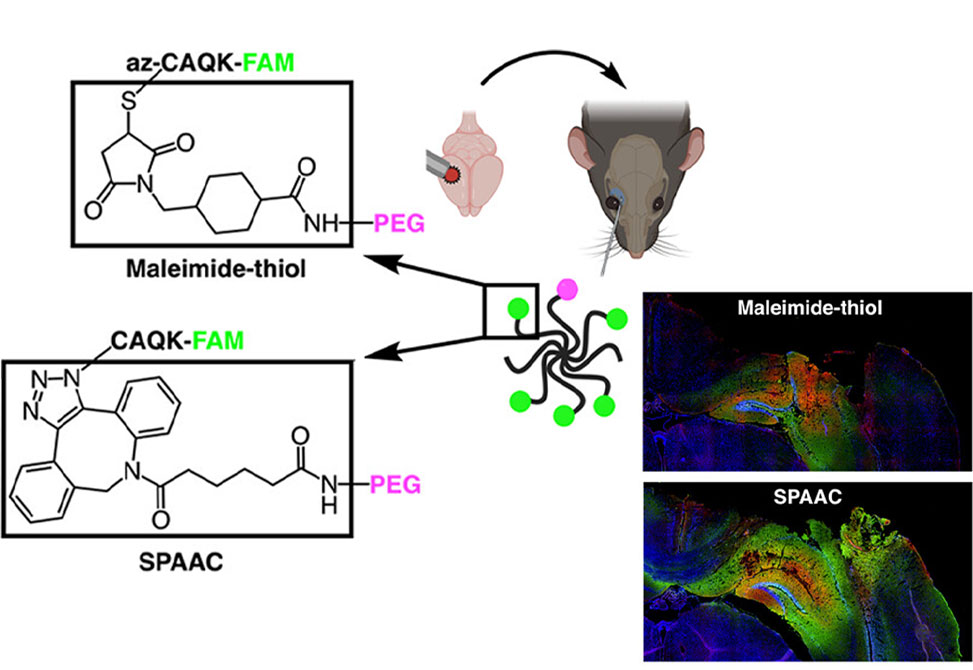Conjugation Chemistry
Reflecting work in the Kwon Lab
Traumatic brain injury, TBI, remains a profound and unresolved clinical challenge, responsible for long-term disability in both civilian and military populations. The lack of effective pharmacological interventions stems, in part, from poor drug bioavailability in the injured brain. In particular, the blood–brain barrier, BBB, disruption following TBI creates a transient therapeutic window that remains underexploited. Among emerging strategies, the extracellular matrix, ECM, represents a compelling target, with upregulated components like tenascin-C serving as molecular beacons of injury. The short peptide CAQK, Cys-Ala-Gln-Lys, has previously demonstrated selective affinity for injury-induced ECM remodeling and holds promise as a targeting moiety for delivering therapeutics post-TBI. However, like most peptides, CAQK suffers from rapid systemic clearance and poor pharmacokinetics that limit its therapeutic potential.
In this study, published in Bioconjugate Chemistry by researchers from the Ester J. Kwon Lab at Department of Bioengineering, University of California, La Jolla, systematically investigates whether PEGylation, a gold standard in extending peptide half-life—can effectively transform CAQK into a viable delivery vehicle for TBI applications. Moreover, the group members explore how linker chemistry, often treated as a technical afterthought, has profound implications on biodistribution, clearance, and targeting efficiency. Using an 8-arm, 40 kDa poly-ethylene-glycol, PEG, scaffold, the researchers synthesized CAQK–PEG conjugates via two orthogonal conjugation chemistries: maleimide–thiol Michael addition and strain-promoted azide–alkyne cycloaddition, SPAAC, using DBCO–azide coupling. Both conjugates achieved equivalent peptide loading, ∼5 CAQK per PEG, and purity, ensuring a controlled comparison of linker-dependent pharmacokinetics.
Pharmacokinetic analyses revealed that PEGylation extended the circulation half-life of CAQK by ~90-fold compared to the free peptide, effectively mitigating its rapid renal clearance. Upon systemic administration in a mouse model of controlled cortical impact, CCI, both CAQK-PEG conjugates demonstrated robust localization to the injured brain cortex. This accumulation was driven by both passive targeting through BBB disruption and active engagement with tenascin-C, as confirmed by colocalization in immunostained brain sections. Notably, the PEG-conjugated CAQK remained in the injured cortex for up to 24 hours, whereas free peptide was rapidly eliminated.
Despite comparable brain targeting, the two conjugation strategies diverged sharply in their off-target biodistribution. DBCO-linked conjugates exhibited significant retention in filtration organs, particularly the liver, kidneys, and spleen, driven by hydrophobic interactions and increased complement activation associated with the DBCO moiety. In contrast, maleimide-linked conjugates demonstrated faster clearance from non-brain tissues, likely owing to the more labile thiol-based linkage, resulting in a more favorable pharmacokinetic profile for CNS-targeted therapeutics.
The study further explored the concept of peptide-based prophylaxis, a particularly relevant strategy for military personnel at high risk of TBI. Remarkably, a single intravenous dose of maleimide-linked CAQK–PEG administered 24 hours prior to injury led to significant accumulation in the injured cortex, 4.5% injected dose per gram of tissue, a dramatic improvement over the free peptide, which was undetectable under the same conditions. This finding demonstrates that the prolonged circulation afforded by PEGylation, combined with injury-specific ECM targeting, can enable pre-emptive delivery to the brain—a paradigm-shifting approach for at-risk populations.
Taken together, this work underscores the critical role of conjugation chemistry in shaping the pharmacokinetic landscape of peptide–polymer therapeutics. While both PEGylation strategies successfully enabled brain targeting, the maleimide–thiol conjugates offered reduced off-target organ retention, enhancing their potential for clinical translation in TBI. The findings carry broader implications for the design of nanotherapeutics aimed at neuroinflammatory conditions, where balancing prolonged circulation with controlled clearance is paramount. Future work will need to consider alternative polymers to mitigate anti-PEG immunogenicity and refine linker stability to further optimize the therapeutic index of peptide-based nanomedicines.


